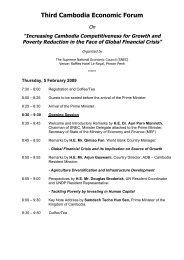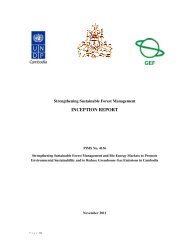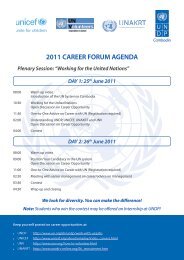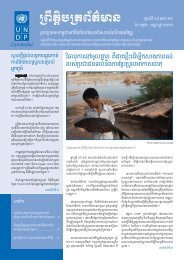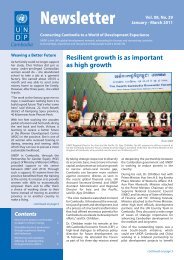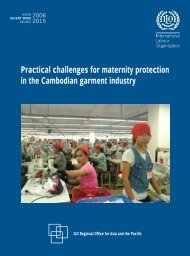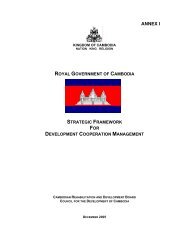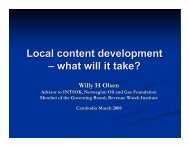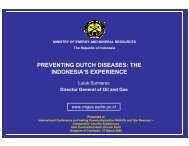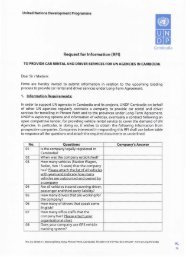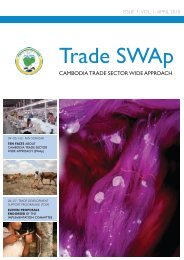UN Analysis Final.pdf - United Nations in Cambodia
UN Analysis Final.pdf - United Nations in Cambodia
UN Analysis Final.pdf - United Nations in Cambodia
Create successful ePaper yourself
Turn your PDF publications into a flip-book with our unique Google optimized e-Paper software.
8.2.1 YOUTH PARTICIPATION IN DECISION-MAKING DEVELOPMENT<br />
Accord<strong>in</strong>g to the World Youth Report 2007, provid<strong>in</strong>g young people a chance to take part <strong>in</strong> decision-mak<strong>in</strong>g<br />
helps shape their own development, prepar<strong>in</strong>g them for a role <strong>in</strong> enhanc<strong>in</strong>g and strengthen<strong>in</strong>g their<br />
societies, and subsequently creat<strong>in</strong>g a better environment for youth participation. This entails, however, broad,<br />
synergistic feedback mechanisms that give youth the space to provide their <strong>in</strong>puts or that permit a dialogue<br />
between young people, their families, local leadership groups and others who can be critical to the positive<br />
paths that youth can take for their advancement. Often, however, exclusion is more common.<br />
Elders and local authorities th<strong>in</strong>k that youths have less experience <strong>in</strong> development, therefore, their ideas have<br />
been ignored ...– Fathers’ FGD, Siem Reap<br />
The elders and village chief only call youths to a meet<strong>in</strong>g if there is conflict among young people. The<br />
youths are never called on to participate <strong>in</strong> draft<strong>in</strong>g the village development plan...– FGD, 20-24 year olds,<br />
Siem Reap<br />
There are presently no structures that br<strong>in</strong>g youths <strong>in</strong>to discussions of national or local development. Because<br />
local leaders do not consult youth on development issues – s<strong>in</strong>ce their views are not appreciated – youth<br />
concerns are not adequately represented and reflected <strong>in</strong> village (or district and prov<strong>in</strong>cial) development<br />
priorities and budgets. Youths expressed confidence, however, of their ability to contribute to development.<br />
For them, the social environment and conservative beliefs of the l authorities and elders <strong>in</strong> their communities<br />
prevent them from mak<strong>in</strong>g a contribution. This suggests that youths have a positive view of their role,<br />
imply<strong>in</strong>g that a national youth policy – accompanied by <strong>in</strong>stitutional mechanisms that support young<br />
people’s voluntary engagement – could br<strong>in</strong>g on their more active participation <strong>in</strong> decision mak<strong>in</strong>g with<strong>in</strong><br />
and possibly outside their communities.<br />
8.2.2 YOUTH PARTICIPATION IN VOL<strong>UN</strong>TEERISM<br />
The <strong>United</strong> <strong>Nations</strong> def<strong>in</strong>es volunteerism as “actions undertaken out of free choice, not motivated by<br />
f<strong>in</strong>ancial ga<strong>in</strong>, and br<strong>in</strong>g<strong>in</strong>g benefit to the community, volunteer, and society at large” (<strong>United</strong> <strong>Nations</strong><br />
General Assembly 2008). In <strong>Cambodia</strong>, several studies l<strong>in</strong>k volunteerism to the creation of social capital<br />
and to engender<strong>in</strong>g reciprocity (Brown 2008; Mysliwiec 2005; Dara 2001; Ebihara 1968). This is because<br />
volunteerism fosters trust, a basic component to the concept of social capital, as it leads people to cooperate<br />
towards their shared goals. In the absence of assets <strong>in</strong> the 1990s and even today, poor <strong>Cambodia</strong>n people<br />
have relied on their relationships, associations and networks to survive on a day-to-day basis, through<br />
voluntarily shar<strong>in</strong>g or reciprocat<strong>in</strong>g labour, cash, food, <strong>in</strong>formation, services and emotional support <strong>in</strong> times<br />
of crisis such as ill health (Rakodi, 2002). These are the key elements of social capital that characterize<br />
rural communities – elements that build on trust and that can lead to mean<strong>in</strong>gful participation <strong>in</strong> community<br />
activities and events.<br />
The World Youth Report of 2007 notes that “volunteerism is a clear manifestation of youth participation <strong>in</strong><br />
society – one that is often altruistic and devoid of immediate selfish <strong>in</strong>terests.” It helps build <strong>in</strong>terpersonal<br />
and social skills and strengthens personal potential. For example, promot<strong>in</strong>g volunteerism and expand<strong>in</strong>g<br />
opportunities for youth participation <strong>in</strong> development benefits larger society, and can be part of a strategy to<br />
combat social ills such as drug abuse, juvenile del<strong>in</strong>quency and other deviant behaviour, particularly among<br />
youth (<strong>United</strong> <strong>Nations</strong> 2007).<br />
92 Situation <strong>Analysis</strong> of Youth <strong>in</strong> <strong>Cambodia</strong>




